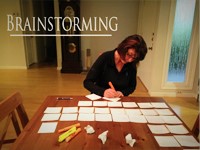Brainstorming Tips For Writing A Talk That Matters

This month I’m going to focus on how to actually write a talk that matters. We’ve talked about making sure we start with our “Why” (our core driving purpose), understanding that our goal is to equip our audience with the tools they need to go out and be amazing, and then focusing that into ONE key take-away message. But if that is the end game, how do we start?
BRAINSTORMING
There are many methods for brainstorming out there, but everyone agrees that this is the time to include everything. Personally, I cut up scratch paper to simulate notecards (ever the recycler) and write down one idea per card. If the idea is too broad, I break it down to the details and crumple up the broad idea card. I go on tangents with my ideas and generate more cards. I go to webpages I have bookmarked and write down those ideas (I capture my sources on the back of these cards). I start to ask myself “why is this important / what is the benefit”. And if there is a good answer, that becomes another notecard. I ask “what is the risk to this idea”, “what is involved in executing this idea”, “what is the cost/revenue analysis”, “who else needs to be convinced”, “what would I have to give up to do this thing”, and “what’s the downside of NOT doing this thing”. And then I play the two year old, and keep asking “why”. Every assumption must stand up to at least 3 whys. Every answer becomes a unique notecard. I don’t worry about reading them or editing them, I just keep writing.
For me, this process takes multiple sittings because what happens as I dump my ideas onto paper is new ideas get a chance to rise up. My husband laughs because I will have little scraps of paper everywhere! But there comes a moment when I think I’ve exhausted all avenues and it’s time to take stock of where I am.
SORTING
At this point, I create a massive game of solitaire on my dining room table with my notecards. I start by stacking them into logical groups. What happens is that I will start with one definition of what makes a group, and then quickly learn that these groups need to be broken down into smaller groups with entirely different criteria. There is no right or wrong here EXCEPT you must never force a notecard into a group it doesn’t really belong with. As such, I often end up with a few stray notecards that don’t fit anywhere.
Once I think I have completed the sorting process, I write a title notecard for the top of each stack. The title should be in the form of a complete sentence.
Come back next week to learn how I get my dining room table back, AND how to successfully move these piles into a talk that matters.
Another of my favorite brainstorming methods is: “The Six Thinking Hats” http://www.triz-journal.com/innovation-methods/innovation-brainstorming-brst/put-six-thinking-hats-brainstorm/.
